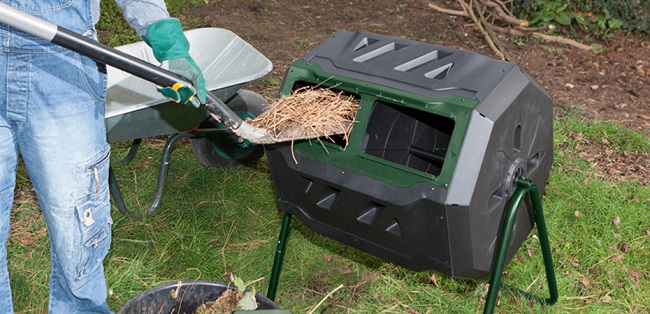If you have recently purchased a compost tumbler bin you have just taken the first step toward aerobic composting. There are two main types of composting, aerobic and anaerobic.

Anaerobic composting basically consists of piling up a bunch of organic materials, then letting them sit and rot. Anaerobic bacteria are slow and inefficient, which means that your compost pile will have to sit there for at least a year, maybe longer, before the materials at the very bottom are fully composted. Second, microbes that do the decaying in anaerobic composting produce methane and sulfate gasses as a byproduct, something which we humans find very offensive. If you’ve always thought of composting as a smelly and gross process, now is the time to make an important clarification: its anaerobic composting that’s a smelly process.
Aerobic composting is an entirely different process. Just as the name would suggest, aerobic composting requires air, specifically oxygen, to complete its process. Aerobic bacteria are very efficient. They break down organic matter very rapidly, often completing the full composting process in less than 6 weeks. Furthermore, aerobic microbes don’t give off smelly gasses, which makes aerobic composting is a virtually odorless process.
A compost tumbler bin is the best way to get started with aerobic composting. Usually designed in a cylindrical shape, compost tumblers spin on an axis, tumbling the materials inside and providing the necessary oxygen for aerobic composting to occur. While it is possible to construct your own compost tumbler, the process isn’t easy, and you may find that you’ll save yourself a lot of time and frustration by purchasing a ready to assemble unit. Compost tumbler bins are readily available for purchase through online and catalog stores or your local garden center. Many can be assembled in minutes.
Once you’ve got your compost tumbler bin set up, you’re ready to begin aerobic composting. The first step is to add the materials to be composted. First and foremost, it is not advisable to put any meat or dairy products (including egg yolks) into an aerobic composter unit, because these will produce foul odors as they break down, thereby defeating your goal of odor-free composting. Vegetable peelings, old bread, cooked rice, pasta, and other similar kitchen scraps can and should be added to an aerobic compost bin. Houseplant trimmings, lint from the dryer, floor sweepings, and pet hair are also things that can be put in a composter.
From the outdoors, there are a multitude of items that can be composted such as yard trimmings, dead leaves, grass clippings, dead flowers, etc. Other things that can be added to your compost tumbler include pencil shavings, sawdust, chopped up hay or straw, and aquarium plants. When you first begin using your composter, you need to build up adequate bacteria levels to break the materials down. To this end, it’s a good idea to add some bulking materials in the beginning, such as peat moss or already finished compost, if you have a source for getting some.
With a little time and effort, you’ll have finished compost readily available from your aerobic compost bin. This finished compost can be tilled into your garden soil or added to the topsoil around existing plants as a fertilizer. You’ll soon begin to see the results that compost has on a garden with bigger plants, more flowers, and larger harvests of vegetables.
Ellen Bell works for a retail website that offers many home and garden products.
Related Articles & Free Email Newsletter
Be a Worm Farmer and Make Your Own Compost
How to Have Great Compost in 3 Months




Comment here